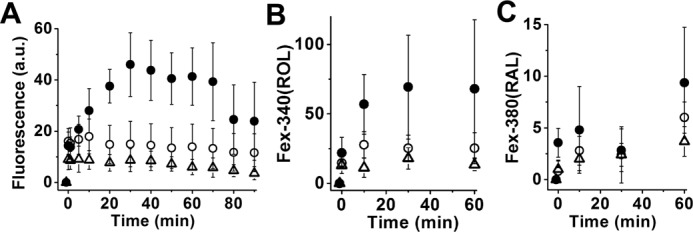Figure 8.

Bleaching rod photoreceptors in the presence of IRBP results in strong reduction of outer segment fluorescence due to all-trans-retinol and all-trans-retinal. Metabolically intact rod photoreceptors from wild-type mice were bleached in the absence and in the presence of different concentrations of IRBP. Bleaching took place between t = −1 and 0 min. A, outer segment fluorescence (excitation, 360 nm; emission, >420 nm) due to both all-trans-retinol and all-trans-retinal at different times after bleaching in the absence (●, n = 8) of IRBP and in the presence of 2 μm (○, n = 10) or 5 μm (▵, n = 13) IRBP. B and C, outer segment fluorescence due to all-trans-retinol (B) and all-trans-retinal (C) at different times after bleaching in the absence (●, n = 7) of IRBP and in the presence of 2 μm (○, n = 6) or 5 μm (▵, n = 5) IRBP. B and C, fluorescence signals Fex-340(ROL) and Fex-380(RAL) due, respectively, to all-trans-retinol and all-trans-retinal were measured simultaneously in the same cells. Error bars represent standard deviations.
